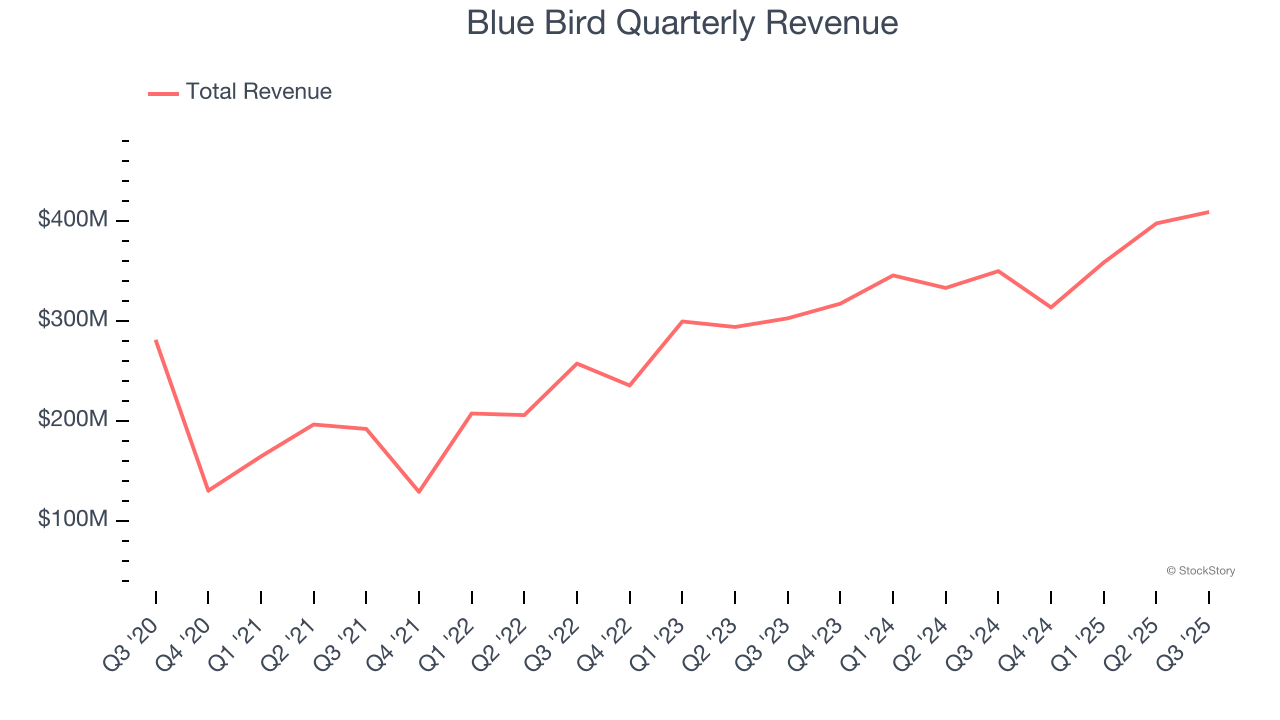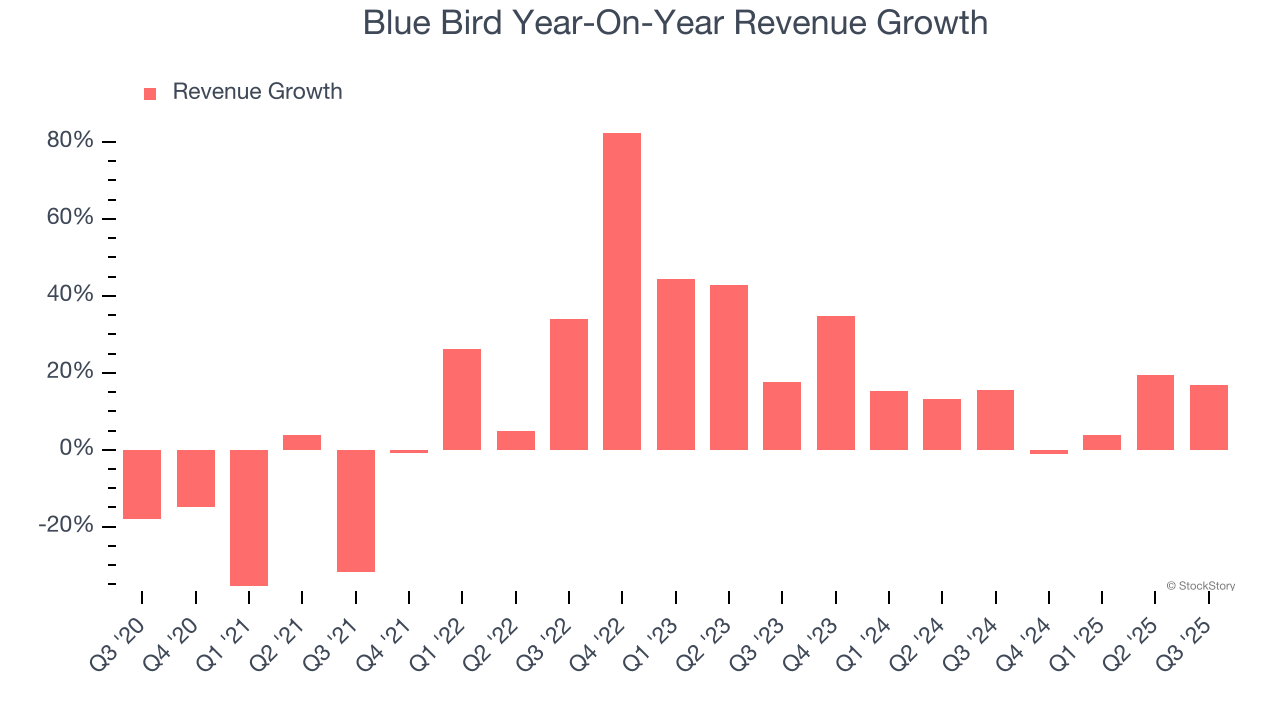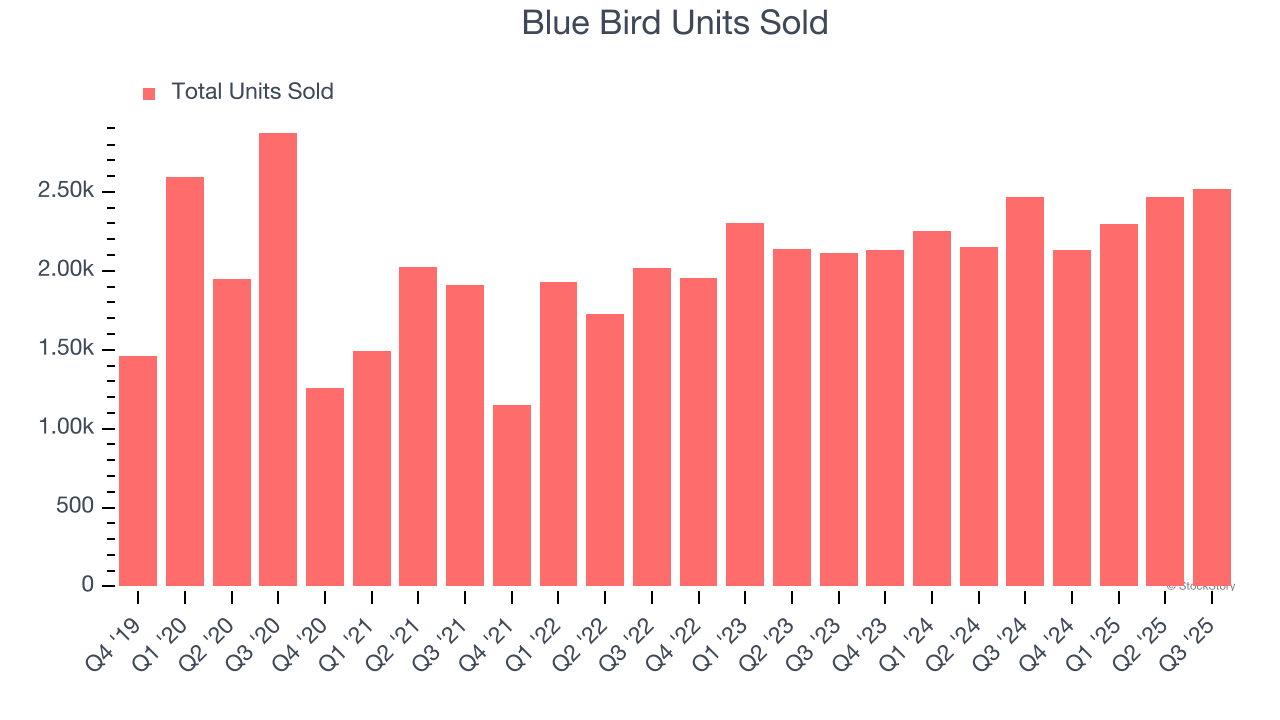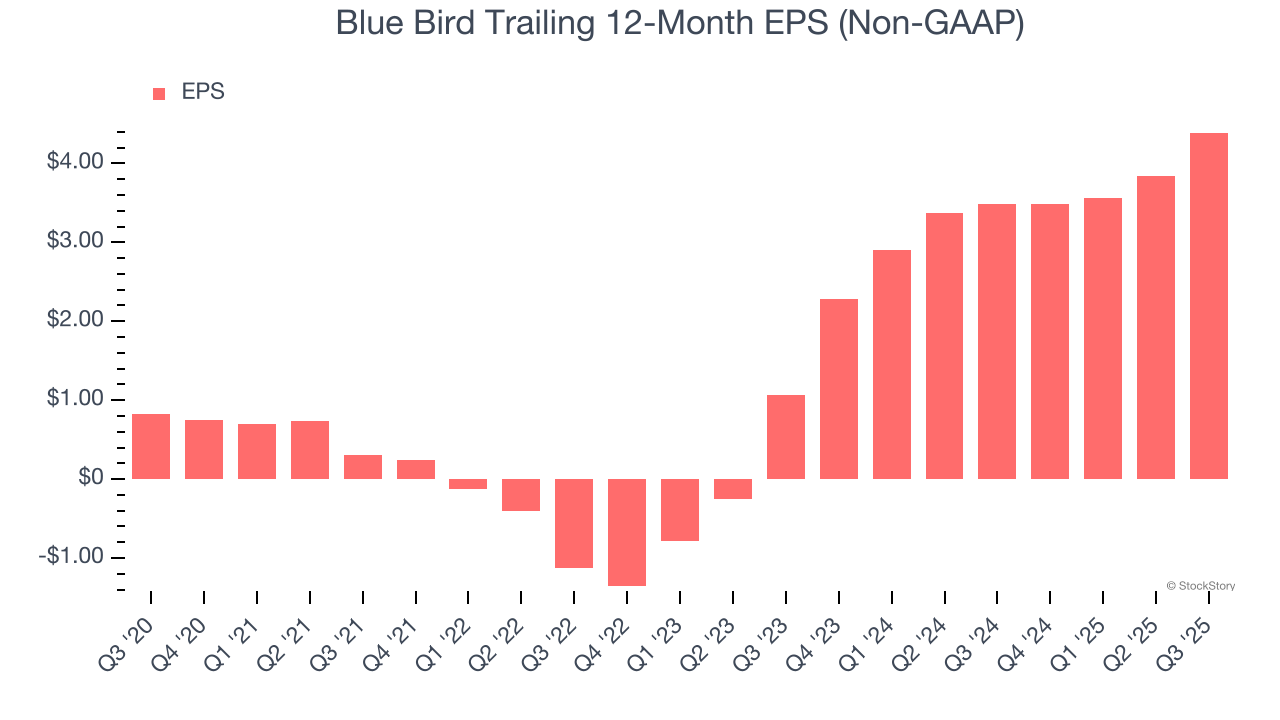
School bus company Blue Bird (NASDAQ:BLBD) announced better-than-expected revenue in Q3 CY2025, with sales up 16.9% year on year to $409.4 million. On the other hand, the company’s full-year revenue guidance of $1.5 billion at the midpoint came in 0.9% below analysts’ estimates. Its non-GAAP profit of $1.32 per share was 29.1% above analysts’ consensus estimates.
Is now the time to buy Blue Bird? Find out by accessing our full research report, it’s free for active Edge members.
Blue Bird (BLBD) Q3 CY2025 Highlights:
- Revenue: $409.4 million vs analyst estimates of $380 million (16.9% year-on-year growth, 7.7% beat)
- Adjusted EPS: $1.32 vs analyst estimates of $1.02 (29.1% beat)
- Adjusted EBITDA: $67.9 million vs analyst estimates of $54.26 million (16.6% margin, 25.1% beat)
- EBITDA guidance for the upcoming financial year 2026 is $220 million at the midpoint, in line with analyst expectations
- Operating Margin: 12.3%, up from 7.3% in the same quarter last year
- Free Cash Flow Margin: 14.8%, similar to the same quarter last year
- Sales Volumes rose 2.1% year on year (16.5% in the same quarter last year)
- Market Capitalization: $1.71 billion
“I am incredibly proud of our team in delivering another outstanding result, achieving a new all-time record revenue and profit for the quarter and year,” said John Wyskiel, President & CEO of Blue Bird Corporation.
Company Overview
With around a century of experience, Blue Bird (NASDAQ:BLBD) is a manufacturer of school buses and complementary parts.
Revenue Growth
A company’s long-term sales performance can indicate its overall quality. Any business can put up a good quarter or two, but many enduring ones grow for years. Luckily, Blue Bird’s sales grew at an impressive 11% compounded annual growth rate over the last five years. Its growth surpassed the average industrials company and shows its offerings resonate with customers, a great starting point for our analysis.

We at StockStory place the most emphasis on long-term growth, but within industrials, a half-decade historical view may miss cycles, industry trends, or a company capitalizing on catalysts such as a new contract win or a successful product line. Blue Bird’s annualized revenue growth of 14.3% over the last two years is above its five-year trend, suggesting its demand was strong and recently accelerated. Blue Bird’s recent performance shows it’s one of the better Heavy Transportation Equipment businesses as many of its peers faced declining sales because of cyclical headwinds. 
We can dig further into the company’s revenue dynamics by analyzing its number of units sold, which reached 2,517 in the latest quarter. Over the last two years, Blue Bird’s units sold averaged 5.3% year-on-year growth. Because this number is lower than its revenue growth, we can see the company benefited from price increases. 
This quarter, Blue Bird reported year-on-year revenue growth of 16.9%, and its $409.4 million of revenue exceeded Wall Street’s estimates by 7.7%.
Looking ahead, sell-side analysts expect revenue to grow 3.3% over the next 12 months, a deceleration versus the last two years. This projection doesn't excite us and suggests its products and services will see some demand headwinds. At least the company is tracking well in other measures of financial health.
While Wall Street chases Nvidia at all-time highs, an under-the-radar semiconductor supplier is dominating a critical AI component these giants can’t build without. Click here to access our free report one of our favorites growth stories.
Operating Margin
Operating margin is an important measure of profitability as it shows the portion of revenue left after accounting for all core expenses – everything from the cost of goods sold to advertising and wages. It’s also useful for comparing profitability across companies with different levels of debt and tax rates because it excludes interest and taxes.
Blue Bird was profitable over the last five years but held back by its large cost base. Its average operating margin of 6% was weak for an industrials business. This result isn’t too surprising given its low gross margin as a starting point.
On the plus side, Blue Bird’s operating margin rose by 10.3 percentage points over the last five years, as its sales growth gave it immense operating leverage.

This quarter, Blue Bird generated an operating margin profit margin of 12.3%, up 5 percentage points year on year. The increase was encouraging, and because its operating margin rose more than its gross margin, we can infer it was more efficient with expenses such as marketing, R&D, and administrative overhead.
Earnings Per Share
We track the long-term change in earnings per share (EPS) for the same reason as long-term revenue growth. Compared to revenue, however, EPS highlights whether a company’s growth is profitable.
Blue Bird’s EPS grew at an astounding 39.9% compounded annual growth rate over the last five years, higher than its 11% annualized revenue growth. This tells us the company became more profitable on a per-share basis as it expanded.

Diving into the nuances of Blue Bird’s earnings can give us a better understanding of its performance. As we mentioned earlier, Blue Bird’s operating margin expanded by 10.3 percentage points over the last five years. This was the most relevant factor (aside from the revenue impact) behind its higher earnings; interest expenses and taxes can also affect EPS but don’t tell us as much about a company’s fundamentals.
Like with revenue, we analyze EPS over a shorter period to see if we are missing a change in the business.
For Blue Bird, its two-year annual EPS growth of 103% was higher than its five-year trend. We love it when earnings growth accelerates, especially when it accelerates off an already high base.
In Q3, Blue Bird reported adjusted EPS of $1.32, up from $0.77 in the same quarter last year. This print easily cleared analysts’ estimates, and shareholders should be content with the results. Over the next 12 months, Wall Street expects Blue Bird’s full-year EPS of $4.39 to shrink by 1.5%.
Key Takeaways from Blue Bird’s Q3 Results
It was good to see Blue Bird beat analysts’ EPS expectations this quarter. We were also excited its EBITDA outperformed Wall Street’s estimates by a wide margin. On the other hand, its full-year revenue guidance slightly missed. Overall, we think this was a decent quarter with some key metrics above expectations. The stock traded up 1.1% to $55.50 immediately after reporting.
Blue Bird put up rock-solid earnings, but one quarter doesn’t necessarily make the stock a buy. Let’s see if this is a good investment. If you’re making that decision, you should consider the bigger picture of valuation, business qualities, as well as the latest earnings. We cover that in our actionable full research report which you can read here, it’s free for active Edge members.
